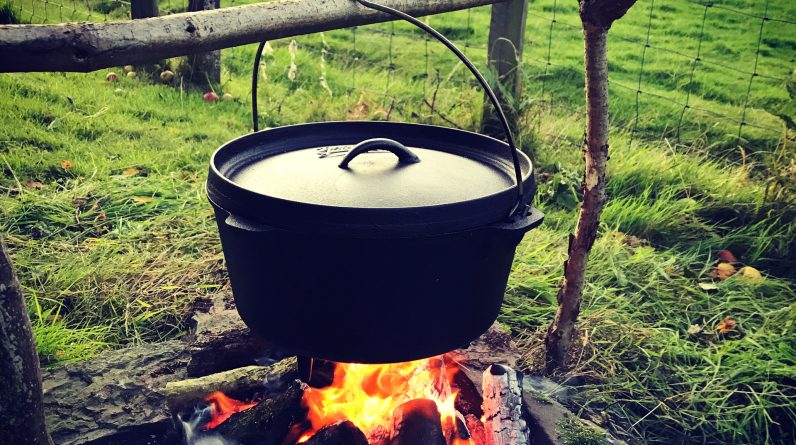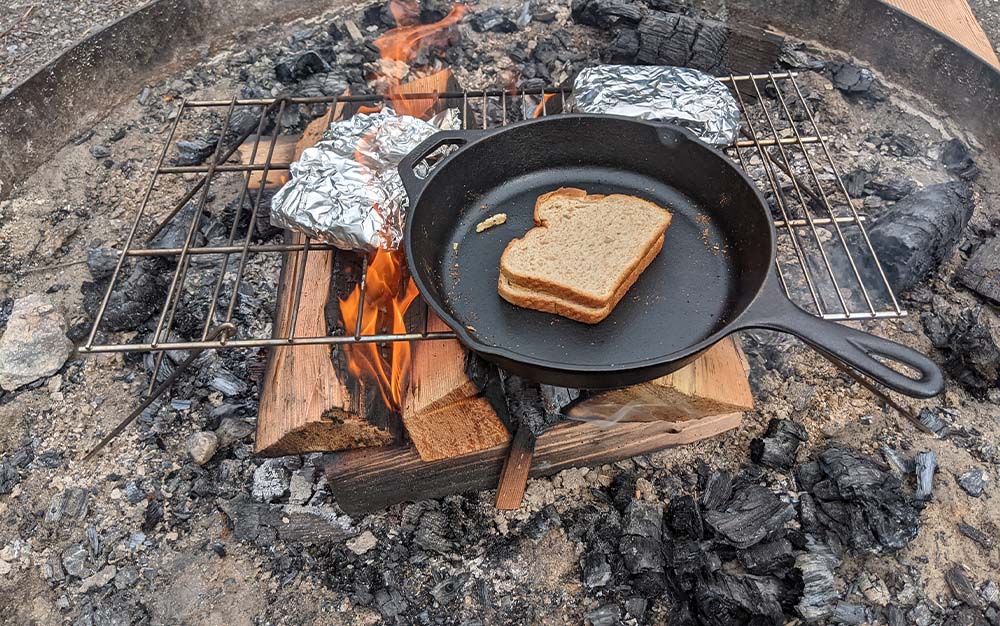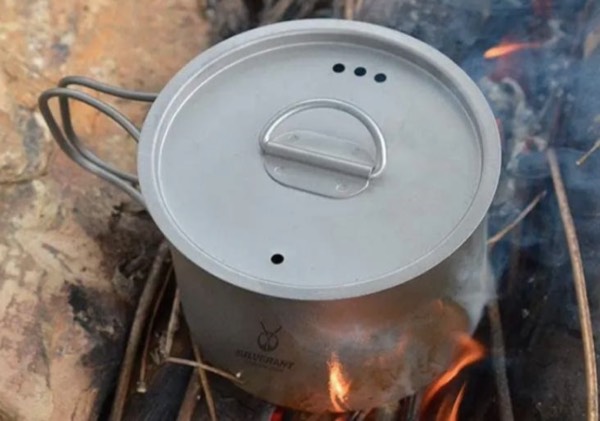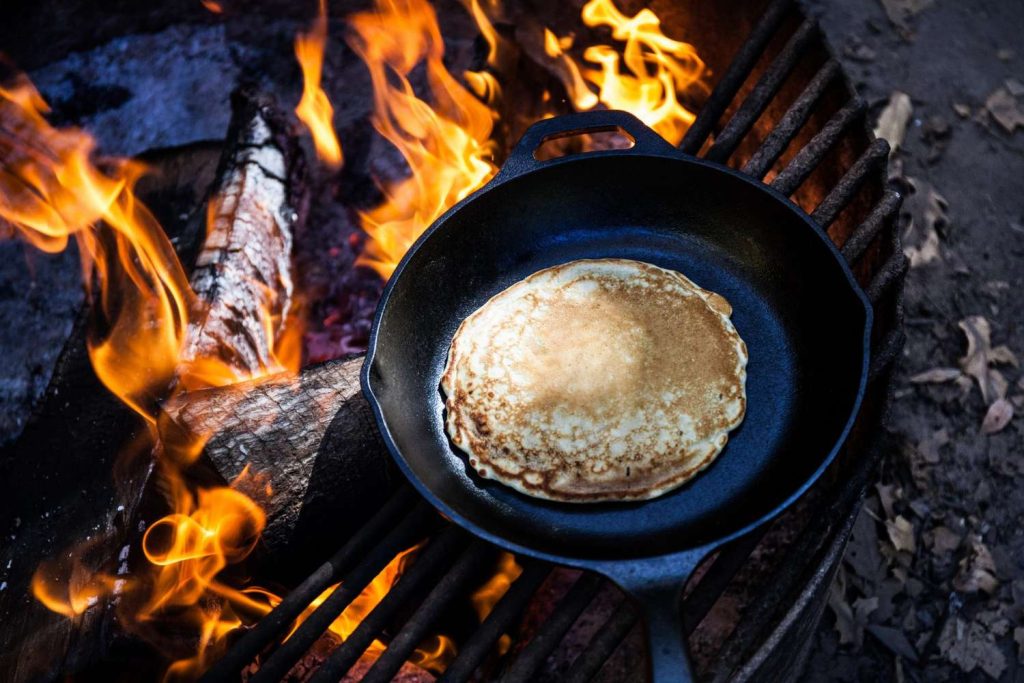
In this article, you will learn how to safely use a regular pan on a campfire. Many people wonder if it is possible to use a regular pan on a campfire, and the answer is yes! With a few simple precautions and techniques, you can enjoy cooking over an open fire with your favorite pan.
First and foremost, it is important to choose the right pan for the job. Opt for a pan that is made of sturdy materials such as cast iron or stainless steel, as these can withstand the high heat of a campfire. Avoid using pans with non-stick coatings, as these can release harmful toxins when exposed to high temperatures. Additionally, make sure the pan has a long handle or use a heat-resistant mitt or glove to protect your hands from the heat. With the right pan in hand, you can now proceed to safely cook your meals over a campfire.

This image is property of www.outdoorlife.com.
Using a Regular Pan Safely on a Campfire
When it comes to cooking on a campfire, many people assume that specialized camping cookware is necessary. While camping cookware can certainly be convenient, you can also use a regular pan safely on a campfire with a few simple precautions. In this article, we will guide you through the process of choosing the right pan, preparing it, setting up the campfire, using the pan, maintaining the heat, cooking, cleaning and caring for the pan, as well as fire safety precautions.
Choosing the Right Pan
The first step in using a regular pan on a campfire is to choose the right pan. There are a few factors to consider when selecting a pan: the material, size, and handle design.
Material of the Pan
When it comes to the material of the pan, it is important to choose one that can sustain high heat. Cast iron and stainless steel pans are excellent choices for campfire cooking. Cast iron pans are known for their heat retention and even cooking, making them perfect for cooking over an open fire. Stainless steel pans are durable and can withstand high heat, making them another good option for campfire cooking.
Size of the Pan
The size of the pan you choose will depend on the number of people you plan to cook for. It is important to choose a pan that will fit comfortably on your campfire while still providing enough space to cook your meals. A pan that is too big may not heat evenly, while a pan that is too small may not hold enough food. Consider the number of burners on your campfire as well, as this may also affect the size of the pan you can use.
Handle Design
The handle design of the pan is another important factor to consider. Look for a pan with a handle that is sturdy and heat-resistant. Ideally, the handle should be long enough to keep your hands away from the flames and adjustable, so you can easily move or remove the pan from the fire when needed. Some pans come with detachable handles, which can be a convenient feature for camping.
Preparing the Pan
Once you have chosen the right pan for your campfire cooking, it is important to prepare it properly. There are two main steps in preparing the pan: cleaning and seasoning.
Cleaning the Pan
Before using your pan on a campfire, it is essential to clean it thoroughly. Remove any stickers or labels, and wash the pan with warm water and dish soap. Scrub away any residue with a sponge or brush, paying special attention to the cooking surface. Rinse the pan with clean water and dry it thoroughly.
Seasoning the Pan
Seasoning your pan is crucial to prevent food from sticking and to enhance the flavor of your meals. Seasoning also helps to create a protective layer on the pan’s surface, preventing rust and improving its longevity. To season your pan, coat it with a thin layer of cooking oil and place it on a campfire or in an oven. Heat the pan until the oil starts to smoke, then remove it from the fire or oven and let it cool. Repeat this process a few times to build up the seasoning layer.
Setting Up the Campfire
Before using your pan on the campfire, it is important to set up the fire properly. There are two key steps in setting up the campfire: selecting the campfire site and creating a solid base.
Selecting the Campfire Site
When choosing the campfire site, look for a location away from low-hanging trees and other flammable objects. Ensure that the campfire will not be a hazard to your surroundings. Clear the area of any dry leaves, twigs, or debris that could catch fire. It is also important to check local regulations and guidelines regarding campfires, as some areas may have restrictions or require permits.
Creating a Solid Base
To create a solid base for your campfire, start by clearing the ground of any vegetation or flammable materials. Dig a shallow pit or create a ring of rocks to contain the fire. This will help to prevent the fire from spreading. Make sure the rocks are stable and will not shift during cooking. Place a layer of sand or gravel at the bottom of the pit to provide additional protection.
Using the Pan on the Campfire
Now that your pan and campfire are ready, it is time to start cooking! There are two main steps in using the pan on the campfire: adding cooking oil and placing the pan on the fire.
Adding Cooking Oil
To prevent food from sticking to the pan, it is important to add cooking oil before cooking. Choose an oil with a high smoke point, such as vegetable oil or canola oil. Pour a small amount of oil onto the pan’s cooking surface and spread it evenly with a brush or paper towel. This will create a non-stick surface and help to distribute the heat evenly.
Placing the Pan on the Fire
Carefully place the oiled pan on the campfire, ensuring that it sits securely on the base. Adjust the positioning of the pan to ensure that it is level, as this will help to ensure even cooking. Use oven mitts or heat-resistant gloves to handle the pan, as it can become extremely hot. Never touch the pan with bare hands while it is on the fire.
Maintaining the Heat
Maintaining the heat of the campfire is crucial for successful cooking. There are two main methods for controlling the heat: adjusting the fire and using coals or flames.
Adjusting the Fire
To adjust the heat of the campfire, you can either add or remove wood from the fire. Adding more wood will increase the heat, while removing wood will reduce the heat. Use tongs or a fire poker to safely adjust the size and intensity of the flames. Remember to keep a safe distance from the fire and avoid leaning directly over it.
Using Coals or Flames
In addition to adjusting the fire, you can also control the heat by utilizing either the coals or the flames. Placing the pan directly on the flames will provide high heat and a quicker cooking time. On the other hand, placing the pan on a bed of hot coals will provide a more even and controlled heat. Experiment with both methods to find what works best for your cooking needs.
Cooking on the Campfire
Now that your pan is on the fire and the heat is maintained, it is time to start cooking! There are a few steps to consider when cooking on the campfire: choosing recipes and prepping ingredients.
Choosing Recipes
When choosing recipes for campfire cooking, consider the simplicity of the dish and the availability of ingredients. Look for recipes that require minimal preparation and can be cooked in a single pan. This will help to streamline the cooking process and minimize the cleanup. Classic campfire recipes such as foil-wrapped vegetables, one-pot stews, and grilled sandwiches are great options to start with.
Prepping Ingredients
Before starting the cooking process, make sure to prep your ingredients beforehand. Wash and cut vegetables, marinate meat, and measure out any necessary spices or seasonings. Having everything ready before you begin cooking will help to streamline the process and ensure that you do not overcook or undercook any ingredients.
Cooking Tips and Techniques
When cooking on a campfire, there are a few tips and techniques to keep in mind to ensure a successful meal. Two important considerations are avoiding hot spots and stirring or flipping.
Avoiding Hot Spots
Campfires often have uneven heat distribution, which can lead to hot spots on the pan. To avoid this, periodically rotate the pan or move it around the fire. This will help to distribute the heat more evenly and prevent certain areas from burning or overcooking.
Stirring and Flipping
To ensure even cooking, it is important to stir or flip the food regularly. This will help to prevent burning and promote even browning. Use a wooden or heat-resistant utensil to stir the ingredients and flip them when needed. Be careful not to overcrowd the pan, as this can make it difficult to stir or flip the food properly.
Cleaning and Caring for the Pan
After enjoying a delicious meal cooked on the campfire, it is important to clean and care for the pan properly. This will help to maintain its quality and longevity. Two essential steps in cleaning and caring for the pan are removing food residue and proper storage.
Removing Food Residue
To remove food residue from the pan, start by letting it cool down. Once it is cool enough to handle, rinse the pan with warm water and use a non-abrasive sponge or brush to scrub away any stuck-on food. Avoid using soap or abrasive cleaners, as they can remove the seasoning on the pan. Dry the pan thoroughly to prevent rusting.
Proper Storage
To ensure the longevity of your campfire pan, it is important to store it properly. After cleaning and drying the pan, apply a thin layer of cooking oil to the cooking surface. This will help to prevent rust and maintain the seasoning. Store the pan in a cool, dry place, away from moisture and humidity. If possible, store the pan with a paper towel or cloth between other cookware to prevent scratches.
Fire Safety Precautions
When cooking on a campfire, it is essential to prioritize fire safety. Always follow these precautions to prevent accidents and ensure a safe cooking experience. Two important fire safety precautions are supervising the fire and extinguishing the campfire.
Supervising the Fire
Never leave a campfire unattended, especially when cooking. Assign someone to be responsible for supervising the fire at all times. Keep a close eye on the flames and monitor the heat to prevent any accidents or emergencies. Have a bucket of water or sand nearby to extinguish the fire if needed.
Extinguishing the Campfire
Before leaving a campsite or going to sleep, it is crucial to properly extinguish the campfire. Allow the fire to burn down completely, then pour water over the embers and coals. Stir the ashes with a stick to ensure that all the embers are extinguished. Repeat this process until the fire is completely out and the ashes are cool to the touch. Dispose of the ashes in a designated area if available, or pack them out with you.

This image is property of fandbstories.com.
Conclusion
In conclusion, using a regular pan safely on a campfire is achievable with the right precautions and techniques. By choosing the right pan, preparing it properly, setting up the campfire correctly, using the pan with care, maintaining the heat, cooking with skill, cleaning and caring for the pan, and prioritizing fire safety, you can enjoy delicious meals prepared over a campfire. So, the next time you go camping, don’t hesitate to bring along your favorite pan and cook up a fantastic meal under the open sky. Happy campfire cooking!

This image is property of www.allrecipes.com.

